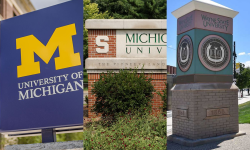Opinion | Tuition-free community college is central to Michigan’s future prosperity
Earlier this year, Governor Whitmer proposed the state guarantee tuition-free community college for all recent Michigan high school graduates. But when the House approved its own spending plan a few weeks ago, the community college guarantee was gone.
Instead, House Democrats called for expanding student eligibility for the Michigan Achievement Scholarship (MAS) and allowing students to use their awards to cover not just tuition but also costs such as books, housing, transportation, and child care.

The issue with the House Democrats’ plan is not the money — more aid and more flexibility in using it is a good thing. It’s about the messaging. Many Michigan students don’t know about MAS or whether they will qualify for it. Figuring out eligibility is complicated. By contrast, a promise of guaranteed tuition coverage sends a clear message that college is affordable and is more likely to broaden the pipeline of students pursuing degrees or credentials.
State Rep. Samantha Steckloff, a supporter of the House budget resolution, was right when she called costs like housing, food, transportation, and child care “some of the most profound hurdles that students have to cross in order to actually go through higher education.” However, research suggests that increased financial aid and greater flexibility in its use aren’t enough to build the workforce Michigan needs.
An educated workforce is central to Michigan’s future prosperity. As the state’s economy evolves and new industries develop, employers are clamoring for workers with degrees or credentials, including the technical qualifications offered by community colleges. For individuals, higher education is still the surest path to a good job.
In 2022, this reasoning led a bipartisan majority of the legislature to enact historic increases in student financial aid in the form of the Michigan Achievement Scholarship. But MAS eligibility is based on something called the Student Aid Index (SAI), an opaque number derived from the Free Application for Federal Student Aid (FAFSA). There is no single threshold for MAS, as the SAI depends on family size, income, and other factors.
As a result, there’s no easy way to know whether you’ll be eligible for MAS unless you submit a FAFSA. This form is challenging to complete at the best of times, and this academic year has been a disaster. Potential students and their families, especially low-income and first-generation college students, may be deterred by the sheer complexity and confusion of the student aid paperwork.
This is where tuition-free college guarantees are particularly valuable. Research shows that simple, straightforward messaging about college affordability boosts access. When it comes to clear communication, a promise that “community college tuition is free for all” wins, hands down.
While Michigan has long been a leader in education, other states have sprinted ahead. Just over half of Michigan residents have a post-secondary degree or credential, putting the state in 37th place when it comes to post-secondary attainment—and a long way from the Sixty by 30 goal.
Some 25 U.S. states have now adopted various approaches to tuition-free college. Michigan policymakers are already familiar with the “College Promise” model, as Michigan Reconnect covers community college tuition for adults in the state without a college degree. But the state lacks the more comprehensive approach taken by states like New Mexico, Tennessee, and Maine, which have seen gains in enrollment after enacting a tuition-free guarantee.
The cost of tuition-free community college for Michigan would be relatively modest. My Upjohn Institute colleagues and I estimated that making community college tuition-free for all recent high school graduates (in a program similar but not identical to the governor’s proposal) would cost approximately $30–40 million per year, while providing $1,000 stipends to help lower-income students address some non-tuition costs would add another $25-30 million annually. (The House plan is similarly priced, with an initial $36 million increase in MAS) While not trivial sums, these are affordable in the context of a proposed $81 billion budget.
The House Democrats’ emphasis on non-tuition costs is important—the biggest barriers to degree or credential completion are not always tuition and indeed are not always financial. But as the budget debate unfolds in Lansing, an equally important lesson should be kept in mind: if students and families don’t understand the financial aid process, the fear of college costs may keep them from even considering this pathway. A simple tuition guarantee that builds on existing state and federal aid can help surmount this fear.
See what new members are saying about why they donated to Bridge Michigan:
- “In order for this information to be accurate and unbiased it must be underwritten by its readers, not by special interests.” - Larry S.
- “Not many other media sources report on the topics Bridge does.” - Susan B.
- “Your journalism is outstanding and rare these days.” - Mark S.
If you want to ensure the future of nonpartisan, nonprofit Michigan journalism, please become a member today. You, too, will be asked why you donated and maybe we'll feature your quote next time!




